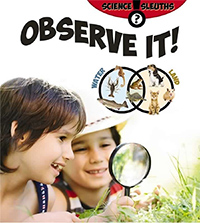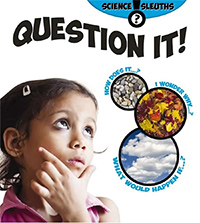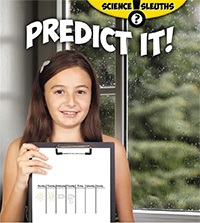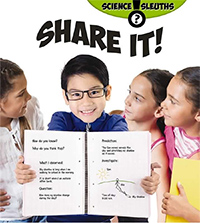| ________________
CM . . . . Volume XXI Number 28 . . . . March 27, 2015
excerpts:
Sharkawy, the author of Crabtree's "Science Sleuths" series, understands young learners and science. Using a variety of well-considered approaches, she helps children to develop the scientific skills and processes that will enable them to begin to make sense of the world as scientists do. As the titles of the four books in the series suggest, readers learn to observe, to question, to predict, and to share the results of their science explorations. To observe scientifically, Sharkawy tells children in Observe It! that it is necessary to use one or more of the five senses and, where possible, to enhance these observations with tools that allow one to measure (e.g., thermometers and rulers) and tools that extend one's ability to see or hear (e.g., magnifying lenses and stethoscopes). Once such detailed observations are made, readers learn that they need to be recorded. Records can be images, words, and numbers. When observations are numerical, Sharkawy helps children to realize that these numbers are best represented in a table, chart, or graph as comparisons can be more easily made. She does so by including a bar graph that shows the temperature at four different locations and asking readers to "find out the difference in temperature between the warmest and coolest places..." Two pages later, they are shown a beetle and two written descriptions of the beetle. In the adjacent "Explore It!" dialogue circle, Sharkawy asks readers to determine which observations of the beetle were "more carefully recorded?" She follows this with information on the properties of materials that can be observed and how such properties or characteristics allow scientists to sort and classify living and non-living objects. Readers are challenged with the task of determining objects that are attracted to a magnet and those that are not and recording their observations in a chart. In Question It!, Sharkawy begins by reviewing scientific observations and tells readers that the questions scientists ask are based on the observations they make. She describes the difference between scientific and non-scientific questions, offers suggestions on how to begin a scientific question (see excerpt above), and explains the relationship between question posing, further observation, and answers that "describe or explain something about the natural world." Throughout the book, she challenges readers to assess questions, to change a statement into a testable question, to rewrite a question so that it can be answered by test or observation, and to observe some aspect of the world, like the spider weaving a web, and ask questions about it. Given that many of the questions young children ask are about living things in the environment, she cautions readers to "question with care" by asking, "Is it safe...?" "Will answering this questions harm any living thing?" Predictions in science are generally referred to as informed guesses. They are based upon knowledge or what a scientist knows and understands and can use to suggest what a future event may be. In Predict It!, Sharkawy links predictions to observations and encourages readers to look for patterns in the observations they record (see excerpt above). These can be observations of changes in a 24 hour day, seasonal changes, changes in temperature from morning to night, changes in the shape and colour of clouds, and short or long-term changes in weather. As she did in Question It!, Sharkawy continues to challenge readers. She encourages them to identify the pattern in a daily temperature tracking chart, to use the data in a tally chart to name the season the weather data describe, to read a description and predict the outcome, and to determine if a statement is a prediction that is based on factual information. Share It! is focused on communication. Sharkawy asks, "Why do scientists share?" "What do scientists share?" and "How do scientists share?" She suggests that readers use a science notebook to clearly and accurately record their observations, questions, planned investigations and data. It is only with this type of information that they are going to be able to share and perhaps have their investigation repeated by others. As far as the "how" in concerned, she suggests that readers use graphic organizers, graphs, diagrams, and photographs, and that they share their reports in written from or orally. Tips are provided for each method of recording information and for both forms of presentation. There is also a list of four investigations being conducted by scientists to which readers can choose to contribute observational data. These "citizen scientist" opportunities are The Great Backyard Bird Count, Firefly Watch, The Great Worldwide Star Count, and Project Squirrel. The URLs provided by Sharkawy enable readers to logon to each website for additional information. Incorporated within the 24 pages of each book in the "Science Sleuths" series are a table of contents, short lists of relevant websites and books, a glossary and index, and numerous stock photographs. The result is a set of four colourful books filled with information and "Explore It!" activities that should interest curious children who wonder about the natural environment in which they live and desire to know more about it. Highly Recommended. Barbara McMillan is a teacher educator and a professor of science education in the Faculty of Education, the University of Manitoba. Copyright © the Manitoba Library Association. Reproduction for personal use is permitted only if this copyright notice is maintained. Any other reproduction is prohibited without permission.
Next Review |
Table of Contents for This Issue
- March 27, 2015. |



